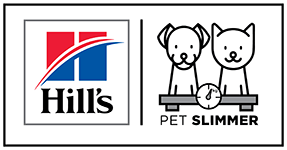

For login details and access to your pets profile and personalized weight loss plan, you will need to first enrol your pet at a Hill’s Pet Slimmer clinic in your area. Click here for more
For login details and access to all your practice’s pet slimmers, you will need to first become a participating Hill’s Pet Slimmer clinic. Click here for more

Overfeeding your dog leads to risk of obesity
You love your dog, and you want to provide him with the best nutrition to keep him in top shape. But when it comes to portion size or the number of snacks you share per day, you're not really sure whether you're giving him too much. Just like humans, there are many health risks for dogs associated with overfeeding your dog. South African vets say more than half the patients they treat are overweight. Consumption of too much dog food or treats may lead to obesity, so it's important to know your pet's eating habits are keeping him healthy.
How Much to Feed Your Dog
The best way to figure out how much to feed your dog is to talk with your veterinarian. Before your next appointment, measure the average serving size of your wet or dry food and mark down how often (and at what times) your dog eats. Also keep a log of how often you feed him snacks, and what kind of food he's given for treats, including rawhide, peanut butter or table scraps.
It helps to bring all of the nutritional labels from your dog's food to an appointment so your vet knows how many calories your dog is consuming and what ingredients are in his food. Doing this will help your vet make sure your pup is receiving the vitamins, nutrients and minerals he needs for a balanced meal plan.
In the meantime, most retail food brands offer suggested portion sizes based on a dog's current weight. Just be aware that if your dog is currently already overweight, the guidelines may not be as helpful as you'd like. Don't reduce your dog's food drastically. Instead, visit your vet for their opinion.
Signs You're Overfeeding Your Dog
Unfortunately, there aren't many obvious signs that you're feeding your pet too much. 9 out of 10 pet parents of overweight pets mistakenly identify their pets’ weight as normal. The more they see other people's dogs of similar weight, it becomes harder and harder to recognize.
If you can easily feel your dog's ribs (but not see them), and he has a "waist" behind his chest, your dog is likely at an ideal weight for his body. Ribs covered by a thick pad of fat or a waist that is barely visible are visual clues that your pet is overweight.
If you have multiple dogs, they might need different kinds of food for their ages and breeds. It's possible the same type of kibble could be overfeeding dog A while giving dog B just the right amount of nutrition.
Risks Associated with Overfeeding Your Dog
There are many short and long term risks for feeding your pet more than he should be eating. According to the Banfield Pet Hospital's 2017 State of Pet Health® report, overfeeding a dog leads to increased medical bills for pet parents. The report suggests that dog parents with an overweight pet spend 17 percent more in healthcare costs than those whose dogs are at a healthy weight. In addition, they spend almost 25 percent more on medications.
The amount spent on medical needs isn't the only alarming thing. What's worse are health risks that overfed pets face. The State of Pet Health study reports that the prevalence of other diseases, such as arthritis and breathing problems, has spiked as more dogs are becoming overweight. The decreased mobility from excess weight also makes healing much more difficult if your dog faces an injury like a fractured limb. Finally, obese dogs tend to lead more sedentary lives, making exercise more difficult to introduce and putting them at risk for heart disease.
You love your pet and would do anything to keep him from getting ill. Don't let another day of potential overfeeding slip by. Take some time to monitor your pet's baseline eating habits, and talk to your vet to see if any changes need to be made. Yes, he may beg or give you those eyes, but dogs don't have the same internal conscious telling them that they're full and will often eat well beyond what they should. It is up to you to help curb your dog's weight by feeding him proper meal sizes.
Contributor Bio
Erin Ollila
Erin Ollila believes in the power of words and how a message can inform—and even transform—its intended audience. Her writing can be found all over the internet and in print, and includes interviews, ghostwriting, blog posts, and creative nonfiction. Erin is a geek for SEO and all things social media. She graduated from Fairfield University with an M.F.A. in Creative Writing. Reach out to her on Twitter @ReinventingErin or learn more about her at http://erinollila.com.
Share this awesome site to spread the awareness of pet obesity